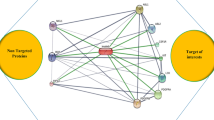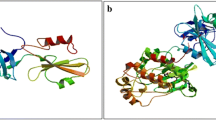Abstract
The discovery of imatinib, a specific inhibitor of Abl kinase, revolutionized the therapeutic approach to chronic myeloid leukemia (CML); however, its efficacy can be impeded by the emergence of novel mutations within the kinase domain, particularly AblT315I, that lead to the development of drug resistance. It therefore remains necessary to identify specific inhibitors that can effectively target imatinib-resistant CML harboring the AblT315I mutation. A natural product library sourced from the ZINC database was screened against the experimental structure of AblT315I kinase to identify compounds that selectively target the mutated kinase. The top-scoring compound was empirically tested for inhibition of AblT315I kinase using a luminescence-based kit and for impact on cellular proliferation using the BaF3-BCR-ABL-T315I stable cell line. Computational docking and molecular dynamic simulations identified the compound SISB-A1, N-[1-(4-bromophenyl)-3-methyl-1H-pyrazol-5-yl]-2-[(2-oxo-4-phenyl-2H-chromen-7-yl)oxy] acetamide, to effectively bind the catalytic domain of the mutant AblT315I kinase. Moreover, SISB-A1 exhibited greater preference than imatinib for amino acid residues of the mutant kinase’s active site, including isoleucine 315. MMPBSA-based Gibbs binding free energy estimation predicted SISB-A1 to have a free energy of −51.5 versus −65.0 kcal/mol for the conventional AblT315I inhibitor ponatinib. Cell proliferation assays showed SISB-A1 to have a GI50 of 164.0 nM against the ABL-T315I stable cell line, whereas imatinib had a GI50 of 5035 nM. The IC50 value obtained for SISB-A1 against the AblT315I kinase was 197.9 nM. The results indicate SISB-A1 to have a notable ability to bind the catalytic domain of the AblT315I mutant kinase and effectively suppress its activity, thereby surpassing the associated resistance to imatinib. Continued advancement of this lead compound has the potential to yield innovative therapeutics for imatinib-resistant CML.





Similar content being viewed by others
Availability of data and material
The datasets generated during and/or analyzed during the current study are available from the corresponding author on reasonable request.
References
Kang Z, Liu Y, Xu L, Long Z, Huang D, Yang Y, et al. The Philadelphia chromosome in leukemogenesis. Chin J Cancer. 2016;35:48.
Soverini S, Bassan R, Lion T. Treatment and monitoring of Philadelphia chromosome-positive leukemia patients: recent advances and remaining challenges. J Hematol Oncol. 2019;12:39.
Luttman JH, Colemon A, Mayro B, Pendergast AM. Role of the ABL tyrosine kinases in the epithelial–mesenchymal transition and the metastatic cascade. Cell Commun Signal. 2021;19:59.
Cohen P, Cross D, Jänne PA. Kinase drug discovery 20 years after imatinib: progress and future directions. Nat Rev Drug Discov. 2021;20(7):551–69.
Hoemberger M, Pitsawong W, Kern D. Cumulative mechanism of several major imatinib-resistant mutations in Abl kinase. Proc Natl Acad Sci USA. 2020;117(32):19221–7.
Pophali PA, Patnaik MM. The role of new tyrosine kinase inhibitors in chronic myeloid leukemia. Cancer J. 2016;22(1):40–50.
Hehlmann R, Lauseker M, Saußele S, Pfirrmann M, Krause S, Kolb HJ, et al. Assessment of imatinib as first-line treatment of chronic myeloid leukemia: 10-year survival results of the randomized CML study IV and impact of non-CML determinants. Leukemia. 2017;31(11):2398–406.
Chaitanya PK, Kumar KA, Stalin B, Sadashivudu G, Srinivas ML. The role of mutation testing in patients with chronic myeloid leukemia in chronic phase after imatinib failure and their outcomes after treatment modification: single-institutional experience over 13 years. Indian J Med Paediatr Oncol. 2017;38(3):328–33.
Srivastava S, Dutt S. Imatinib mesylate resistance and mutations: an Indian experience. Indian J Med Paediatr Oncol. 2013;34(3):213–20.
Poudel G, Tolland MG, Hughes TP, Pagani IS. Mechanisms of resistance and implications for treatment strategies in chronic myeloid leukaemia. Cancers (Basel). 2022;14(14):3300.
Chan O, Talati C, Isenalumhe L, Shams S, Nodzon L, Fradley M, et al. Side-effects profile and outcomes of ponatinib in the treatment of chronic myeloid leukemia. Blood Adv. 2020;4(3):530–8.
Erçalışkan A, Seyhan Erdoğan D, Eşkazan AE. Current evidence on the efficacy and safety of generic imatinib in CML and the impact of generics on health care costs. Blood Adv. 2021;5(17):3344–53.
Braun TP, Eide CA, Druker BJ. Response and resistance to BCR-ABL1-targeted therapies. Cancer Cell. 2020;37(4):530–42.
Rossari F, Minutolo F, Orciuolo E. Past, present, and future of Bcr-Abl inhibitors: from chemical development to clinical efficacy. J Hematol Oncol. 2018;11:84.
Yusoff YM, Seman ZA, Othman N, Kamaluddin NR, Esa E, Zulkiply NA, et al. Prevalence of BCR-ABL T315I mutation in Malaysian patients with imatinib-resistant chronic myeloid leukemia. Asian Pac J Cancer Prev. 2018;19(12):3317–20.
Larocque EA, Naganna N, Opoku-Temeng C, Lambrecht AM, Sintim HO. Alkynylnicotinamide-based compounds as ABL1 inhibitors with potent activities against drug-resistant CML harboring ABL1(T315I) mutant kinase. ChemMedChem. 2018;13(12):1172–80.
Zhao Q, Wu ZE, Li B, Li F. Recent advances in metabolism and toxicity of tyrosine kinase inhibitors. Pharmacol Ther. 2022;237: 108256.
Baier A, Szyszka R. Compounds from natural sources as protein kinase inhibitors. Biomolecules (Basel, Switzerland). 2020;10(11):1546.
Funding
The authors extend appreciation to the Deanship of Scientific Research at King Khalid University, Abha, Saudi Arabia, for funding this work through Grant Number R.G.P.1/283/44.
Author information
Authors and Affiliations
Corresponding author
Ethics declarations
Conflict of interest
The authors declare that there is no conflict of interest related to this study.
Additional information
Publisher's Note
Springer Nature remains neutral with regard to jurisdictional claims in published maps and institutional affiliations.
Supplementary Information
Below is the link to the electronic supplementary material.
Rights and permissions
Springer Nature or its licensor (e.g. a society or other partner) holds exclusive rights to this article under a publishing agreement with the author(s) or other rightsholder(s); author self-archiving of the accepted manuscript version of this article is solely governed by the terms of such publishing agreement and applicable law.
About this article
Cite this article
Al Shahrani, M., Gahtani, R.M., Abohassan, M. et al. Identification by molecular dynamic simulation and in vitro validation of SISB-A1, N-[1-(4-bromophenyl)-3-methyl-1H-pyrazol-5-yl]-2-[(2-oxo-4-phenyl-2H-chromen-7-yl) oxy], as an inhibitor of the AblT315I mutant kinase to combat imatinib resistance in chronic myeloid leukemia. Med Oncol 40, 316 (2023). https://doi.org/10.1007/s12032-023-02182-8
Received:
Accepted:
Published:
DOI: https://doi.org/10.1007/s12032-023-02182-8




